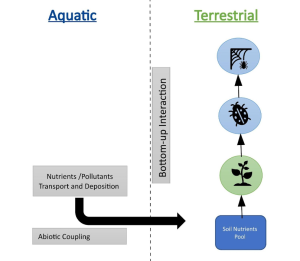Insights into our work
DOCTORAL RESEARCH PROJECTS
Projects 2. cohort
PhD project: Aquatic-terrestrial pollutant transfer
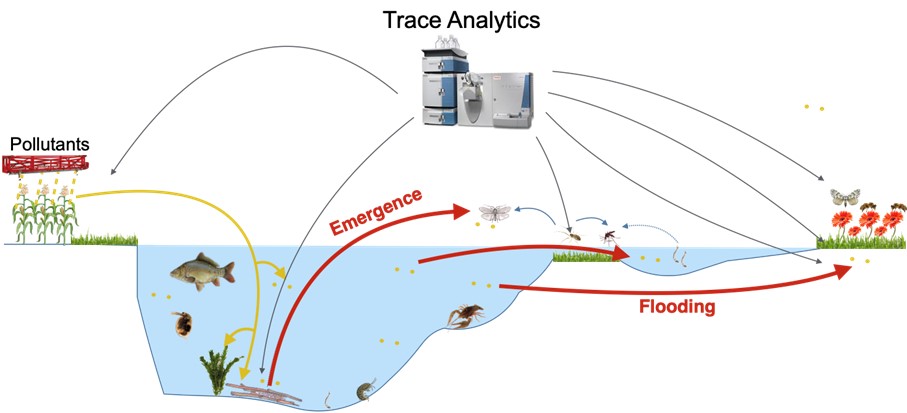
Working title: Flood-related pollutant transfer and its role for effects in terrestrial ecosystems relative to the biological transfer pathway
Supervising scientists: Ralf Schulz, Carsten A. Brühl and Alessandro Manfrin
Doctoral researcher: Franziska Fiolka
Approach: During a preceding PhD project it has been shown that the pollutants transfer via emergence depends on both physico-chemical and biological properties. This project will focus on the pollutant transfer via flooding events and follow the pathway soil-plants-herbivores (bottom-up), on the spatial extent to which pollutants are transferred to the terrestrial system, and on the relative contribution of the flood-related pathway with potential bottom-up effects and the emergence-related pathway with potential top-down effects in the terrestrial environment.
Contact: Ralf Schulz, Ecotoxicology & Environment
Laboratory batch or stream microcosm experiments will be conducted applying a variety of micropollutants in order to quantify, using trace chemical analytics, the potential transfer of micropollutants via the flood-related pathway. A joint Riparian Stream Mesocosm experiment (SystemLink site-scale) will be used to merge the flood-related and the emergence-related pathway for micropollutants. A joint field study will be conducted to quantify aquatic-terrestrial contaminant transfer via various pathways. Both RSM and field study level will be used to ascertain potential population effects on terrestrial predators, such as spiders.
PhD project: Rhizosphere biogeochemistry
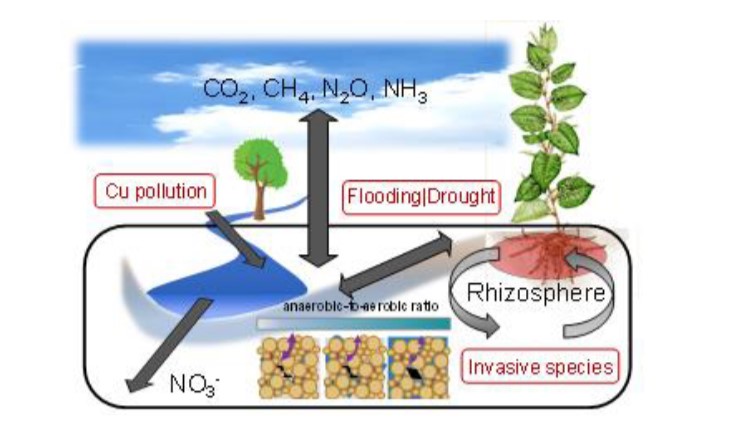
Working title: On the influence of invasive species on biogeochemical cycling in floodplain landscapes under changing water levels
Supervising scientists: Melanie Brunn, Hermann Jungkunst, Clara Mendoza-Lera
Doctoral researcher: Sierra Grange
Approach: Soils are integral for many ecosystem services, such as reducing greenhouse gas emissions or nitrate leaching. Previous work revealed that Fallopia japonica (Houtt.) Ronse Decr., a widespread invasive species across Europe, inhibits nitrification and denitrification. Consequently, biogeochemical cycling in floodplain soils shifts towards greater nitrogen availability increasing the number of electron acceptors that determine the bioenergetic yield during carbon processing. Mechanistically, the rhizosphere activity (quantity and quality of root exudates) and nutrient-use efficiencies of F. japonica are assumed to control the biogeochemical cycling in floodplain soils but the response to flooding and subsequent drought in addition to anthropogenic micropollutant transfers is unknown. This project will focus on bottom-up and top-down controls in riparian ecosystems invaded by F. japonica under predicted variabilities in precipitation and associated fluctuations of water levels with implications for ecosystem functioning.
Contact: Melanie Brunn or Hermann Jungkunst, Geoecology
A microcosm experiment within the Joint Riparian Stream Mesocosm facility (SystemLink site-scale) will be established to test how plant-soil systems biogeochemically respond to fluctuations in flooding frequency and intensity. Fine-scaled insights will be gained in laboratory batch experiments in international cooperation applying micropollutants (copper) and nutrient loads to identify compounds involved in nitrification and denitrification inhibition, ammonia volatilization and nitrous oxide emissions. Field studies (SystemLink field-scale) will identify potential legacy effects and the inclusion of other abiotic and biotic parameters will allow to spatially scale up the identified processes to evaluate the relevance of micropollutant transfer and climate change in ecosystem boundaries between aquatic and terrestrial systems.
PhD project: Aquatic subsidies determine terrestrial biodiversity
Working title: Response of terrestrial communities and populations to variation in aquatic insect subsidies
Supervising scientists: Klaus Schwenk, Martin Entling, Jens Schirmel and Carsten Brühl
Doctoral researcher: Sophie Stoll
Approach: Riparian diversity and community composition are largely determined by aquatic insects. Changes in aquatic resources (e.g. emergence of insects) may result in variation of species composition among terrestrial predators (e.g. spiders and beetles). In addition, changes in aquatic subsidies might alter genetic variation in terrestrial populations and cause natural selection. These processes potentially alter lower trophic levels, such as herbivores and land plants (top-down effects) and even impact nutrient and micropollutant transport.
Contact: Klaus Schwenk, Molecular Ecology
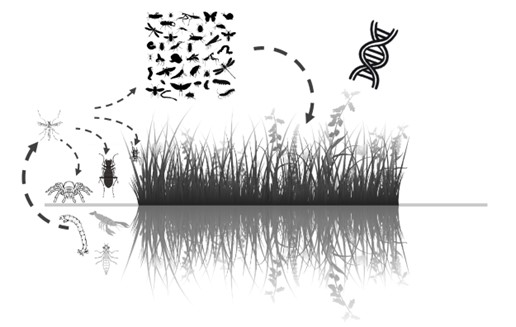
This thesis will focus at community and population processes to unravel the effects of drought and flooding on the community composition (and biodiversity) and genetic variation in aerial web-building and mobile ground hunting spiders and beetles. Varying drought and flooding conditions in floodplain or riparian stream mesocosms will allow us to measure community and population responses of terrestrial organisms using DNA-metabarcoding and population genomics.
PhD project: Top down effects and pollutant system analysis
Working title: Impacts of aquatic stressors on community composition, related top-down interactions in adjacent terrestrial ecosystems and pesticide system analysis
Supervising scientists: Carsten A. Brühl, Ralf Schulz, Martin Entling
Doctoral researcher: Ken Mauser
Approach: Pollutants have impacts on aquatic biodiversity and community composition. This project will focus on effects of reduced emergence of aquatic prey on community composition of three terrestrial predator groups: adult dragonflies (Odonata), web-building spiders (Araneae) and ground beetles (Carabidae). Dragonflies are affected in both aquatic and terrestrial stages whereas spiders and carabids are affected only in the terrestrial system. We hypothesize that impacts on community composition are therefore stronger in dragonflies (resulting in stronger effects on abundance and community composition) than in the two terrestrial predators. Top-down interaction of the predators with herbivorous and pollinating insects, present in the flood-plain area of the Flood Plain Mesocosm experiment (SystemLink site-scale) will be measured.
Contact: Carsten Brühl, Ecotoxicology & Environment
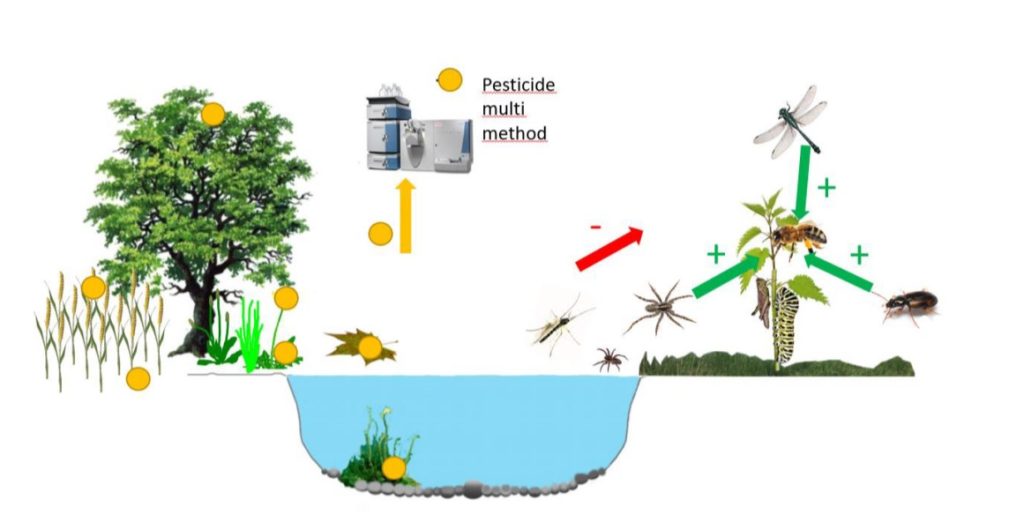
Field studies using similar predator communities will try to evaluate these impacts and resulting changes in community composition of predators, their prey and top-down interactions. In parallel, we aim to describe the flow of realistic pesticide mixtures with an established multi-method through the entire system, from terrestrial into the aquatic compartment and back, focusing on residues in different matrices (sediment /soil, plants, insect and potentially vertebrates) in aquatic, bank/ shore and terrestrial habitats to understand linkages between sub-systems.
PhD project: Subsidy quality in aquatic-terrestrial foodwebs
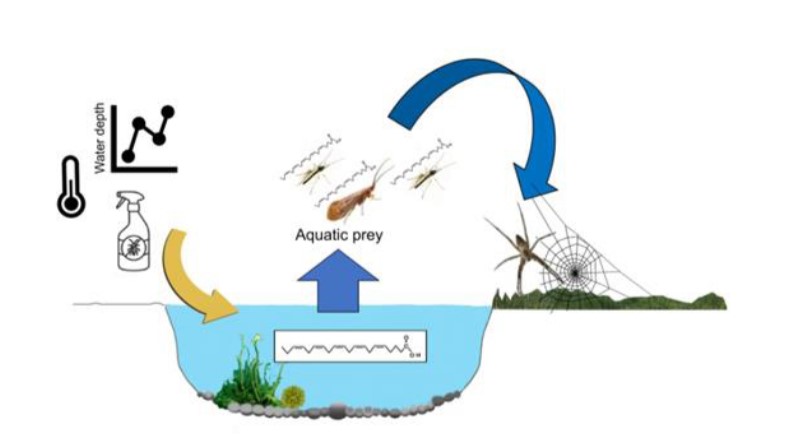
Working title: Subsidy quality – the impact of aquatic emergence on riparian insectivore arthropods
Supervising scientists: Mirco Bundschuh, Alessandro Manfrin, Jens Schirmel
Doctoral researcher: Agnes Schöndorfner
Approach: Aquatic and terrestrial food webs are linked by the emergence of merolimnic insects, which serve as prey for riparian insectivore predators. Stressors such as drought or chemical pollution (including Bti application) can affect the magnitude, temporal dynamics as well as the quality of this subsidy with potential consequences for riparian insectivore arthropods, such as spiders. Building on the knowledge of the first cohort of the SystemLink project, this project will take advantage of laboratory and semi field (focus on enclosures) experiments. Thereby, the project targets the physiology, reproduction and predation of spiders on aquatic as well as terrestrial prey involving besides fatty and amino acid, also stable isotope analyses. Synergisms with parallel projects supervised by Manfrin and Schirmel are expected particularly for the envisaged semi-field experiments. All in all, this project will contribute to a more comprehensive understanding of the trophic implications (i.e., top-down) in recipient riparian food webs induced by subsidy from stressed aquatic ecosystems.
PhD project: Floodplain greenhouse gas emissions
Working title: Greenhouse gas dynamics in floodplain landscapes under hydrological stress
Supervising scientists: C. Mendoza-Lera, A. Lorke, M. Brunn, Martin Entling
Doctoral researcher: Abdullah Rumi Shishir
Approach: Floodplain landscapes are globally significant sources of methane to the atmosphere. This project assesses how the duration and frequency of flooding affects the processes that regulate the production, consumption, and emission of this potent greenhouse gas from local to global scales.
Contact: Clara Mendoza-Lera or Andreas Lorke, Environmental Physics
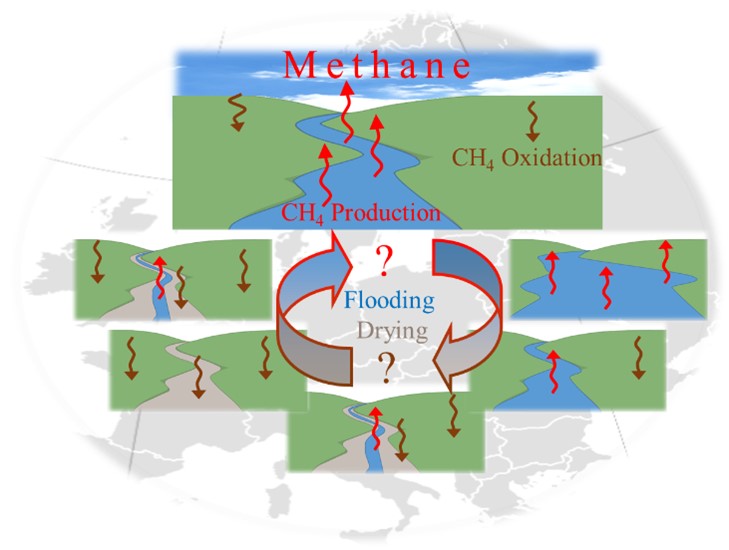
Inland waters, including freshwater wetlands, are the largest natural source of the greenhouse gas methane (CH4). Terrestrial soils, on the contrary, act as a sink for atmospheric CH4. Therefore, dynamic floodplain landscapes can be expected to play an important role in larger-scale greenhouse gas budgets. The extent and dynamics of flooding and drying have been changing globally due to anthropogenic activities and climate change. The resulting hydrological stress is therefore expected to alter the biogeochemical dynamics and greenhouse gas fluxes from floodplain soils and exposed aquatic sediments. The project will analyze how floodplain biogeochemistry and the resulting bottom-up mediated trophic interactions vary with flooding frequency and duration.
The research question will be addressed by experiments conducted at three distinct spatial scales. As part of a joint Riparian Stream Mesocosm experiment (SystemLink site-scale), the project studies CH4 and CO2 fluxes from aquatic and soil compartments in replicated outdoor mesocosm under different flooding scenarios. Among all potential drivers of methane fluxes, aerobic CH4 oxidation is expected to play a key role. The dynamic interaction between CH4 production and oxidation will be analyzed in more detail by exposing sediment and soil samples to dynamic flooding under controlled laboratory conditions. The broader implications and relevance of the findings will be investigated by a crowd-sourced survey of the influence of flooding dynamics on greenhouse gas fluxes at a variety of field sampling sites distributed along climatic and latitudinal gradients (SystemLink field-scale).
PhD project: Aquatic-terrestrial food-web interactions
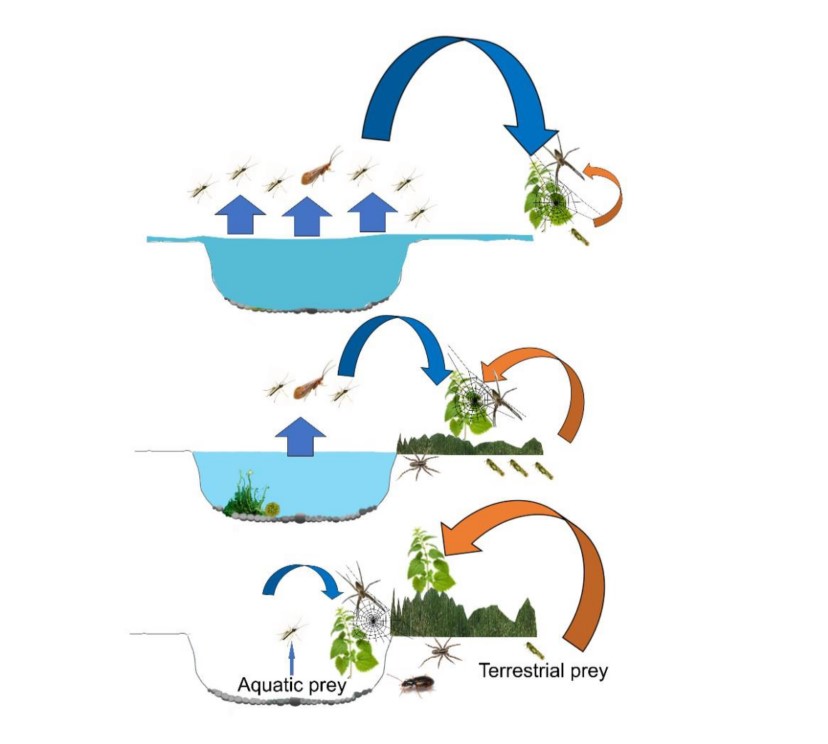
Working title: Effect of hydrological fluctuations on lateral connectivity between aquatic and terrestrial ecosystems and cascading effects on riparian arthropod communities
Supervising scientists: Alessandro Manfrin, Mirco Bundschuh, Martin Entling, Ralf Schulz
Doctoral researcher: Stéphane Mutel
Approach: Hydrological fluctuations as flooding and drying events, are becoming more and more frequent in regions affected by global warming and anthropogenic water abstractions.
Hydrological fluctuations in rivers can affect longitudinal dynamics, but also lateral connectivity by changes in aquatic and riparian habitat configuration. This can result in changes of fluxes of aquatic insects, from the donor aquatic to the recipient terrestrial ecosystem, where they are a key resource for consumers such as spiders. The effect of hydrological fluctuations can thus cascade on the riparian ecosystem affecting the structural and functional composition of riparian arthropod communities via top-down and bottom-up effects.
Experiments and arthropod collection will be performed in field mesocosms within a joint Riparian Stream Mesocosm (RSM) experiment (SystemLink site-scale), in cooperation with other SystemLink PhD projects. Also, collection will be performed seasonally to assess dynamics related to different emergence phenology of the aquatic and riparian arthropod community.
PhD project: Aquatic subsidies in terrestrial food webs
Working title: Propagation of aquatic insect subsidies into terrestrial food webs, and consequences for top-down effects on herbivores and plants
Supervising scientists: Martin Entling, Klaus Schwenk, Andreas Lorke, Jens Schirmel
Doctoral researcher: Alanah Kripp
Approach: Emerging aquatic insects are a key resource for predators in riparian ecosystems. However, the use of aquatic subsidies can differ greatly between functional groups of terrestrial predators (e.g. web building and hunting spiders) and between ecosystems (e.g. forest and open land). In addition, intra-guild predation is common among arthropods. Aquatic subsidies are expected to affect the dynamics of terrestrial food webs, e.g. via top-down effects of spiders on herbivores and land plants. The structure of the food web will also affect the transport of e.g. nutrients and aquatic micropollutants into terrestrial ecosystems.
Contact: Martin Entling, Ecosystem Analysis
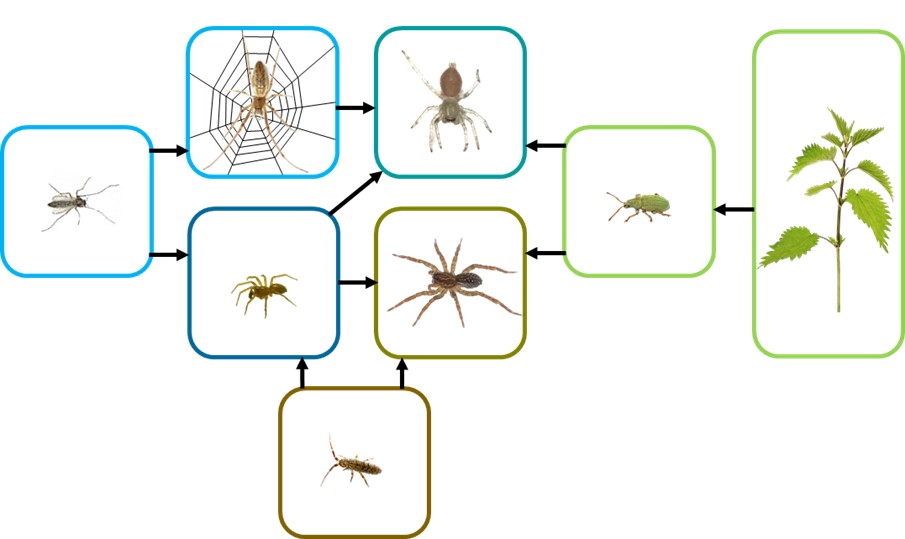
In this thesis, we will analyse the use of aquatic versus terrestrial and intra-guild prey by different functional groups of terrestrial predators using gut content metabarcoding. We will compare the propagation of aquatic prey subsidies into riparian ecosystems from streams with different levels of anthropogenic stress, such as drought and pollution. In addition, we will estimate the effects of subsidies on terrestrial trophic interactions via the patterns of predator and herbivores abundance, and plant damage.
PhD project: Floodplain C-N dynamics
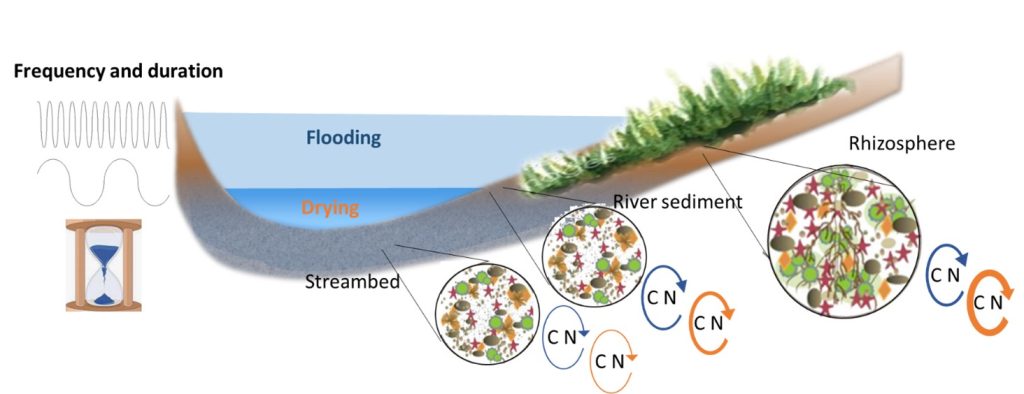
Working title: Carbon and Nitrogen dynamics under hydrological stress in the floodplain mosaic
Supervising scientists: Mathilde Knott, Dörte Diehl, C. Mendoza-Lera, Katherine Muñoz
Doctoral researcher: Sacha Ferrer
Approach: Floodplains are dynamic biogeochemical mosaics and can be pivotal biogeochemical hotspots in the landscape. This projects explores the hydrological and biological controls of their biogeochemistry.
Contact: Mathilde Knott or Dörte Diehl, Environmental and Soil Chemistry
Floodplains are spatio-temporal dynamic ecosystems defined by repetitive and inhomogeneous (location-dependent) flooding, which shapes floodplains in mosaics composed of three main compartments: sediment, soil and rhizosphere, which differ strongly in their biogeochemical processes. The biogeochemistry of these compartments is also constrained by the flooding regime. Local properties such as the microbial community inhabiting and the availability of contaminants, nutrients, carbon and oxygen modulate the biogeochemistry of these compartments. Yet, it remains unclear how constraints (Flooding and anthropogenic factors such as Cu) and local properties hydrological stress interact to determine the biogeochemistry of this ecosystem. Therefore, our overarching research question is: how does biogeochemical processing vary in the floodplain mosaic compartments as a function of large-scale constraints (flooding/drying, top-down controls of trophic interactions) and local properties (microbial communities, Cu contaminant, nutrient and carbon content and quality, bottom-up controls of trophic interactions)?
The research question will be addressed by experiments conducted at the joint Riparian Stream Mesocosm experiment (SystemLink site-scale), together with other SystemLink PhD projects, combining methods and concepts from freshwater and soil science, e.g., respirometry (CarbOBot), thermal analyses (TGA-DSC-MS), and spectrometric analyses (ATR-IR, UV-VIS and fluorescence).
PhD project: Modelling of aquatic-terrestrial flows
Working title: Integration and analysis of bottom-up and top-down cross-ecosystem models in the context of environmental stressors
Supervising scientists: Ralf B. Schäfer, Shawn Leroux, Andreas Lorke and Alessandro Manfrin
Doctoral researcher: Tobias Elsässer
Approach: During a previous PhD project, a generic food web model has been developed for the aquatic terrestrial system, incorporating resource quantity and quality, with the aim to study top-down effects. In addition, a spatially explicit stream network model has been developed to study bottom-up effects. This project will focus on the integration of the two models into a spatially-explicit ecosystem model with riparian patches of terrestrial food chains, which are influenced by biotic and abiotic flows from the stream, located along a stream network. The model will be used to study patch and network dynamics from a theoretical and applied perspective.
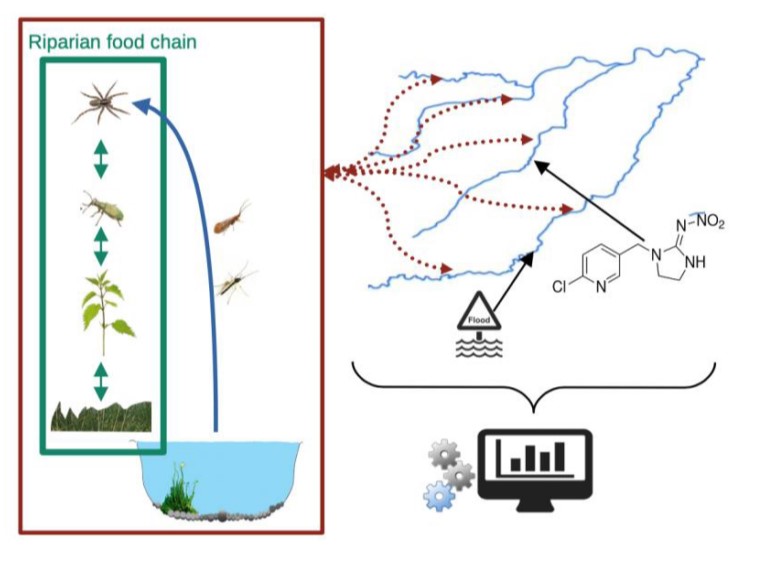
The results of different spatial and temporal scenarios of the environmental stressors (toxicants, hydrological changes) will be examined to derive predictions that can be confronted with observational data from the SystemLink project as well as to evaluate the contribution of bottom-up and top-down effects to the dynamics and stability of the food chain. We aim to identify generalisable conditions (e.g. ratio of stressor intensities, ratio of interaction strengths between trophic levels) that determine their contribution. Moreover, we will integrate data from the different experimental approaches of SystemLink to leverage the experimental results in terms of predictability and generalisability. In this context, we will focus on the identification of mismatches between results from different experimental approaches that call for clarification in future studies.
Phd project: Soil contamination effects on food webs
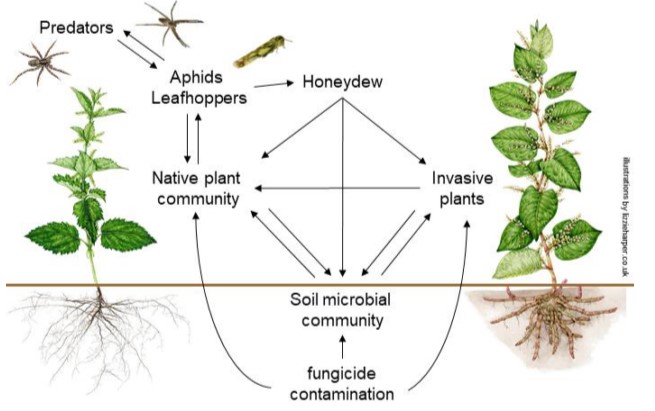
Working title: Interactive effects of fungicide contamination and invasive plants on soil and food webs
Supervising scientists: Kai Riess, Verena Rösch, Klaus Schützenmeister and Stefanie Müller-Schüssele (TUK)
Doctoral researcher: Elyssa Dubois
Approach: The aim of the proposed project is to study how the bottom-up and top-down trophic cascades in native riparian communities including bacteria, fungi, plants, herbivores and their predators are affected by fungicide contamination from flooding events and invasive plants. Aphids are not only an important prey for predators, but the large amounts of honeydew they excrete are likely to play a role as a resource for soil microorganisms as well. Beside the biological processes, knowledge about the influence of terrestrial ecosystems and their regulating function as a net sink or source for greenhouse-gas fluxes is limited. In this context, data on soil-plant interactions on carbon and nitrogen cycles would increase the understanding of the system. The measurement of soil respiration fluxes is another part of this project since it provides information on the vitality of the soil system (plant-root/microorganism).
Contact: Kai Riess, Ecosystem Analysis
The hypotheses are: (i) Soil fungicide contamination and invasive plants modify the soil microbial community and affect the fitness of riparian plants and thereby of their herbivores and predators. Changes in plant fitness affect the amount and quality of honeydew produced by phloem-feeding herbivores and alter carbon availability in the soil for the microbial community. (ii) The occurrence of invasive plants and subsequent changes in the soil microbial community cause changes in greenhouse gas fluxes. Flooding events stop CH4 uptake into the soil, turning it into a methane source. On the other hand, fungicides in the soil have a positive effect on nitrous oxide fluxes from soil.
The above-mentioned pathways will be studied in a joint greenhouse pot experiment (SystemLink batch-scale). Measurements will include biological parameters, e.g. plant and animal morphology and physiology, microbial diversity and biomass, rounded off by aphid reproduction, daily honeydew secretion and composition. Regarding the soil, measurements of respiration fluxes, C/N, grain size, pH-value and soil conductivity are planned. The greenhouse experiment will be complemented by laboratory work, e.g. fungal growth studies based on aphid excretions and feeding experiments with herbivores and predators.
PhD project: Hydrological effects on riparian food-webs
Working title: Role of aquatic insect emergence and washed-up organisms for riparian food webs under anthropogenic stress
Supervising scientists: Jens Schirmel, Martin Entling, Mirco Bundschuh, Alessandro Manfrin
Doctoral researcher: Franziska Middendorf
Approach: Emerging aquatic insects can be important food subsidies for terrestrial species. Another potential pathway which links aquatic and terrestrial food webs are (dead) aquatic organisms washed ashore (e.g. midge larvae, pupae). In the face of global change, streams are subject to hydrological changes such as temporary drying or increased flood events due to climate change and due to anthropogenic alterations (e.g. water removal for agriculture, stream regulation and bank reinforcement). These changes can affect the magnitude of emerging aquatic insects and organisms washed ashore, which may consequently influence the riparian food web. The project therefore combines top-down (emergence pathway) and bottom-up (flooding pathway) directed effects in the terrestrial food-web.
Contact: Jens Schirmel, Ecosystem Analysis
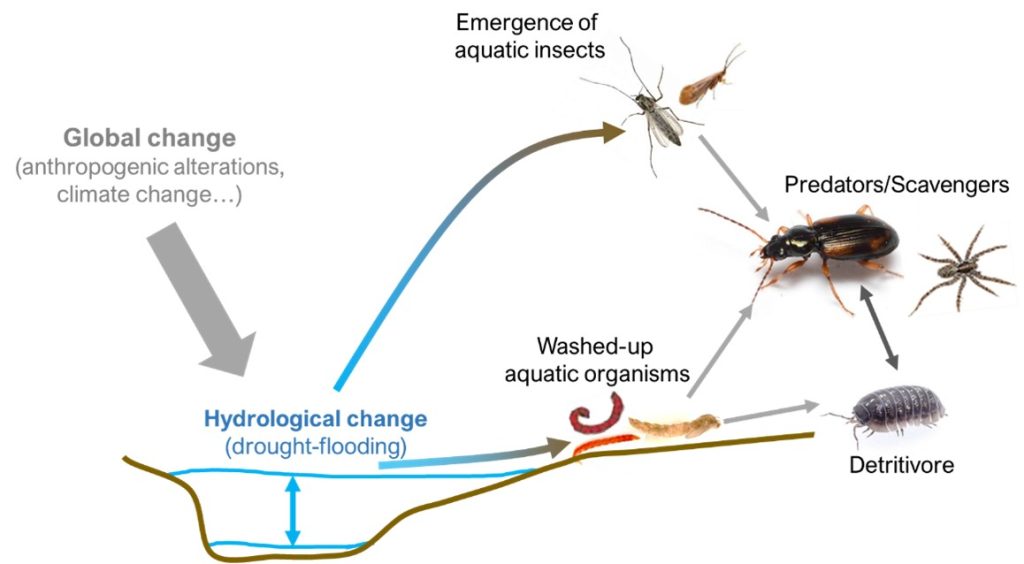
This project aims to i) disentangle the importance of emerging insects vs. organisms washed ashore for riparian predators and scavengers of different functional groups (e.g. carabid beetles, spiders, rove beetles), ii) to analyse the effect of anthropogenically induced hydrological changes (drought-flooding) on these subsidies and iii) to investigate consequences for the functioning of riparian food webs, with a special focus on carnivore-detritivore interactions. Therefore, modern analytical approaches will be used (e.g. metabarcoding, stable isotope analysis) in a combination of experiments and field studies.
Projects 1. Cohort
PhD project: Stress transfer across communities
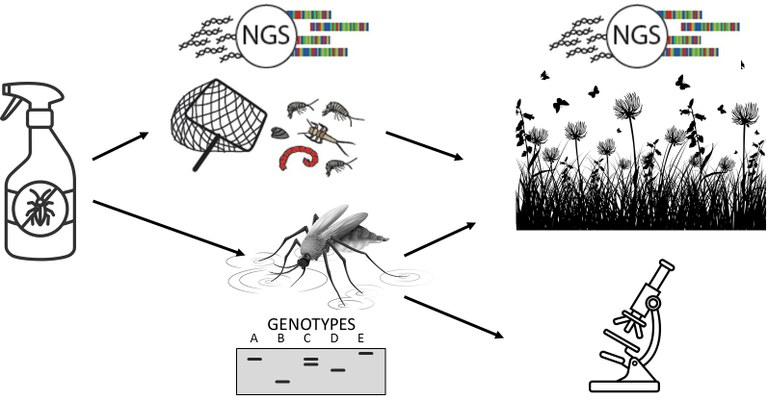
Working title: Transfer of environmental stress across ecosystems: community and species response to aquatic fungicide or insecticide load.
Supervising scientists: Klaus Schwenk, Kathrin Theissinger and Lorenz Fahse.
Doctoral researcher: Nina Röder
Approach: Genetic variation, whether intraspecific or interspecific, largely determines a communities vulnerability to environmental stress. This project aims to study the impact of agricultural pesticides on aquatic and terrestrial communities in riparian ecosystems.
Contact: Klaus Schwenk, Molecular Ecology
Genetic variation, whether intraspecific or interspecific, largely determines a communities’s vulnerability to environmental stress. Likewise, environmental stress can lead to a shift in the gene pool, with potential effects on ecological traits and interlinked species.
This project aims to study the impact of agricultural pesticides on aquatic and terrestrial communities in riparian ecosystems. We will focus on potential pesticide-induced shifts in the aquatic community, which may have an impact on adjoining terrestrial ecosystems. We will use molecular techniques like DNA-(meta)barcoding and metagenomic high‐throughput sequencing approaches, providing valuable insights into the genetic structure of natural communities.
In a pilot study, laboratory batch-scale experiments will give general insights on the effects of pesticides on aquatic community structures, and in particular on the model organism Chironomus riparius. Besides lethal effects and reproductive deficiencies, allele frequency changes will be evaluated. During the second project phase, we plan to test the effect of pesticides on pre-exposed and naive C. riparius populations in common garden experiments. We are planning to analyse the different populations’ viabilities and reproductive success across a pollution gradient. The results of the scheduled experiments will allow for conclusions regarding the potential adaptation and/or pesticide-induced genetic drift of C. riparius populations. At the final stage, the study will be augmented by performing experiments at the SystemLink riparian stream mesocosm (RSM). In this site-scale experiment, more complex effects of agricultural pesticides will be studied with special regard to species composition shifts in a diverse aquatic community. In addition, we will assess potential top-down directed effects in terrestrial systems via joint analyses of species composition, ecological traits and fitness across both ecosystems.
PhD project: Amphibian ecology
Working title: Direct and indirect effects of Bacillus thuringiensis israelensis (Bti) on the European common frog (Rana temporaria) and palmate newt (Lissotriton helveticus)
Supervising scientists: Carsten A. Brühl, Martin H. Entling, Kathrin Theissinger.
Doctoral researcher: Verena Gerstle
Approach: The mosquito control agent Bti has been applied in the floodplain areas on the Upper Rhine. Although it is primarily toxic to larvae of the family Nematocera, negative effects on amphibians on their food web have been observed in laboratory and microcosm studies. The aim of this PhD project is to investigate the effects of anthropogenic stressors like Bti on the food web of amphibians and their role for higher trophic levels in terrestrial ecosystems.
Contact: Carsten A. Brühl, Community Ecology and Ecotoxicology
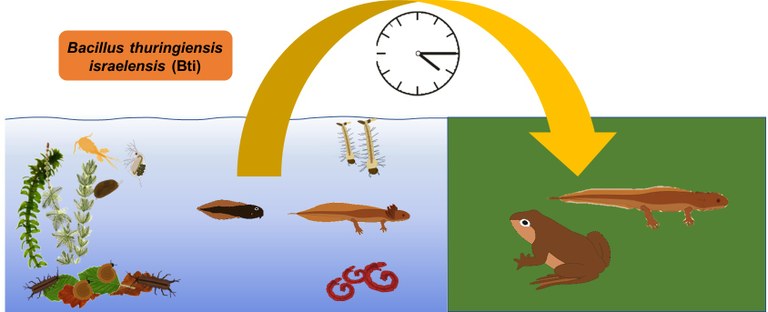
The mosquito control agent Bti has been applied in the floodplain areas on the Upper Rhine for more than 40 years. Although it is primarily toxic to larvae of the family Nematocera due to its specific mode of action, negative effects on amphibians on their food web have been observed in laboratory and microcosm studies.
Since Bti is directly applied into surface waters which also function as breeding habitats for amphibians, the aim of this PhD project is to investigate effects of anthropogenic stressors like Bti on the food web of amphibians and their role for higher trophic levels in terrestrial ecosystems. It is hypothesized that Bti reduces the food quality for amphibians, thus causing temporal emergence shifts. Using the floodplain mesocosms in Eußerthal, we will assess the impact of multiple Bti applications on temporal emergence patterns (phenology) of both amphibians as well as direct effects on different stages of larval R. temporaria and indirect effects on the food web of aquatic R. temporaria and L. helveticus larvae. Therefore, the field experiment is divided into two approaches: (1) Determination of direct sublethal effects using frog larvae in cages for oxidative stress (ROS) and related enzymatic biomarkers, e.g. Glutathione-S-Transferase and Hsp70, and (2) indirect effects on the food web using freely swimming frog and newt larvae for measurements of fatty acids, stable isotopes, proteins and total energy content. Additionally, body mass, length and time-to-metamorphosis of the larvae will be recorded as well as the locomotor activity using video tracking.
We expect that Bti will affect the ecotrophology of amphibian larvae since the abundance of the main food source (chironomids) will be reduced. Simultaneously, a lab feeding experiment with newt larvae will be conducted to imitate limited food sources.
PhD project: Rhizosphere biogeochemistry

Working title: Joint FSstream biogeochemistry (HJ): The impact of anthropogenic stressors on biogeochemical cycling at the root-microorganism-soil interface.
Supervising scientists: Hermann Jungkunst, Katherine Muñoz, Melanie Brunn.
Doctoral researcher: Johanna Girardi
Approach: The invasive plant Fallopia japonica is known for its effective niche construction. Fallopia increases the nitrogen content in the soil-plant system. However, it is still unknown how this interlinked system reacts to external stressors. In the Palatinate Region copper is a frequently used fungicide, which can also reach riparian systems. This Ph.D. thesis aims to identify the levels on which copper interferes with the nitrogen cycle within soil-plant systems.
Contact: Hermann Jungkunst, Geoecology
Plants and soil microorganisms are highly interlinked and control important mechanisms of the carbon and nitrogen cycle together. The invasive plant Fallopia japonica is known for its effective niche construction. By adapting the microbial community and inhibiting denitrification, Fallopia increases the nitrogen content in the soil-plant system. However, it is still unknown how this interlinked system reacts to external stressors.
In the Palatine region copper is a frequently used fungicide, which can also reach riparian systems. This Ph.D. thesis aims to identify the levels on which copper interferes with the nitrogen cycle within soil-plant systems. Therefore, the joint pot experiment will be used, to observe the microbial community structure, microbial enzyme activity and biogeochemical processes in two plant-soil systems (Fallopia japonica and Urtica dioica) under a gradient of copper concentrations. Furthermore, root exudates will be collected in the pots as well as in field sites belonging to the FS stream experiment.
Exudates will be analysed for specific compounds such as flavonoids and the reaction of soil microbial communities to these substances will be tested in laboratory experiments. Thereby we will gain a deeper understanding of the interaction between plants and microorganisms under copper stress and the implications for biogeochemical processes.
PhD project: Biological pollutant transfer
Working title: Implications of physicochemical properties of micropollutants for their emergence-mediated transport to terrestrial ecosystem.
Supervising scientists: Ralf Schulz, Gabriele E. Schaumann and Alessandro Manfrin.
Doctoral researcher: Alexis Roodt
Approach: Adult merolimnic insects emerging from streams in agricultural landscapes contribute to a variety of ecosystem functions. However, these species are increasingly exposed to a broad range of plant protection products with diverse physiochemical properties. In this project we propose to investigate several current use pesticide actives with a range of physiochemical properties and water-borne exposure patterns.
Contact: Ralf Schulz, Ecotoxicology & Environment
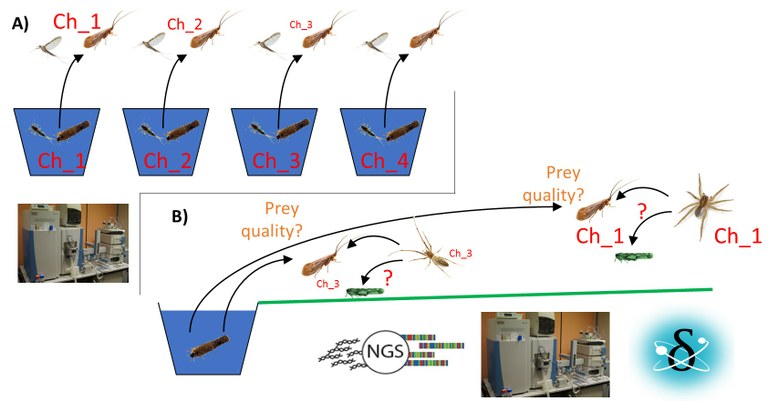
Adult merolimnic insects emerging from streams in agricultural landscapes contribute to a variety of ecosystem functions, furthermore, they serve as an important subsidy in adjacent terrestrial food-webs. However, during their development, the larvae and nymphs of such species are increasingly exposed to a broad range of plant protection products with diverse physiochemical properties. Among these anthropogenic chemicals, organic pesticides have the potential to be accumulated or concentrated in the bodies of developing larvae. The subsequent emergence of which may potentialy increase the exposure risk of terrestrial food webs when pesticides are retained in the body burden of the imagines.
In this project we propose to investigate several current use pesticide actives with a range of physiochemical properties and water-borne exposure patterns. Insects from a range of orders commonly found in European agricultural landscapes will be used in laboratory-batch and mesocosm scale exposure experiments. The resulting body burdens of pesticide active ingredients will be quantified by application of liquid chromatographic (LC) and gas chromatographic (GC) analysis hyphenated with tandem mass spectrometry (MS/MS).
The results of these experiments will be used to evaluate the potential spatial transport of pesticides into adjacent terrestrial ecosystems and the related effect on the population dynamics of predatory spider populations.
PhD project: Biogeochemical fluxes
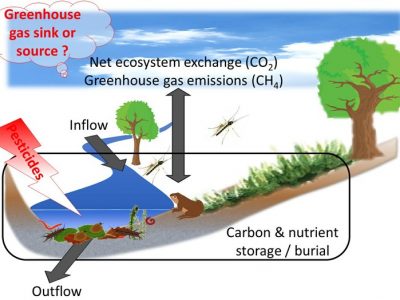
Working title: Effects of chemical stressors on biogeochemical processes and fluxes in water to land transition zones.
Supervising scientists: Andreas Lorke, Clara Mendoza-Lera and Alessandro Manfrin
Doctoral researcher: Caroline Ganglo
Approach: Land-water transition zones are hotspots of biogeochemical cycling
and make substantial contributions to ecosystem functions at regional to global scales. The project investigates how ecosystem functions in land-water transition
zones, including the emission of greenhouse gases and the retention of nutrients, are affected by chemical and hydrological stressors.
Contact: Andreas Lorke, Environmental Physics
Land-water transition zones are hotspots of biogeochemical cycling and make substantial contributions to ecosystem functions at regional to global scales. The project investigates how ecosystem functions in land-water transition zones, including the emission of greenhouse gases and the retention of nutrients, are affected by chemical and hydrological stressors. Although these functions are predominantly mediated by microbial communities, we hypothesize that they are affected by stressors acting on higher trophic levels.
The effect pathways are not only of biotic nature, but include also indirect, physically-mediated pathways, like bio-turbation and bioirrigation. We test this hypothesis using an ecosystem-scale mass balance approach as part of the joint mesocosm experiment (Floodplain Mesocosms FPM) in combination with targeted laboratory experiments. In replicated treatments, the mesocosms will be treated with the Biological mosquito control agent Bti (Bacillus thuringiensis israelensis) and subject to repeated short-term flooding of their terrestrial compartments. Carbon (C) and nutrient (N, P) budgets will be estimated by quantifying all relevant material fluxes and pools. In addition to physically controlled flux paths (water flow, atmospheric evasion and diffusion), we will include mass fluxes of C, N and P associated with motile organisms, including invertebrates and amphibians. Observed differences in the biogeochemical cycling at the landwater interface among the treatments will be related to the application of Bti. Special emphasize will be spent on the identification and mechanistic understanding of the hydrodynamic processes that govern the most relevant physical transport processes in floodplain ponds. This aspect of our research will fill an existing knowledge gap in the field of physical limnology.
Similar to former studies that have been conducted in smaller mesocosms, we expect that Bti has adverse effects on the abundance of non-target organisms, such as chironomids, which are important mediators for the transport of oxygen across the sediment-water interface. In laboratory experiments, we analyze the indirect effects of Bti application on the production, oxidation and evasion of the potent greenhouse gas methane (CH4) as a function of abundance and absence of chironomids.
PhD project: Soil C-N dynamics
Working title: Implications of the interplay between invasive plant colonization and soil structure for the biogeochemical carbon and nitrogen cycle.
Supervising scientists: Gabriele E. Schaumann, Eva Kröner, Verena Rösch.
Doctoral researcher: Jellian Jamin
Approach: Native (U. dioica) and invasive plants (I. glandulifera) have different rootsystems. These will strongly alter soil structure, carbon turnover and the thermodynamics of the soil . We will investigate these interplays on lab-, batch- and landscape scale.
Contact: Gabi Schaumann, Soil & Environmental Chemistry
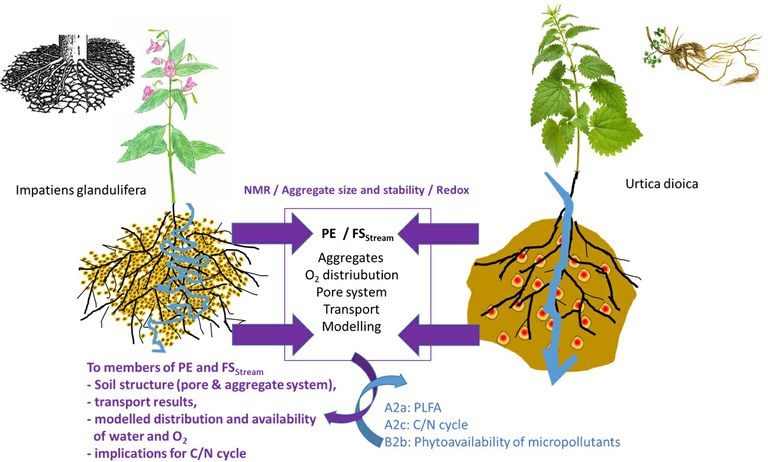
Native (U. dioica) and invasive plants (I. glandulifera) have different root systems. These will strongly alter soil structure, carbon turnover and the thermodynamics of the soil. We will investigate these interplays on lab-, batch- and landscape scale. For this, we participate in two joint experiments: the SystemLink joint pot experiment (joint PE) and the SystemLink FSstream (project Bottom-up effects) with selected populations of both root systems.
During and after the growing season we will assess root structure and soil hydraulic properties via micro-CT-scans and environmental scanning electron microscopy. Micro-respiration experiments with a long incubation time and thermodynamic measurements (e.g. via heat probes) will help to roughly estimate the effect of water and oxygen distribution on carbon conversion efficiency and carbon turnover thermodynamics. Furthermore, we will select suitable biomolecules e.g. from the root exudates to characterize the carbon conversion efficiency by compound-specific isotope analysis.
Water retention and soil pore size distribution in the rhizosphere will be characterized via 1Dand 2D nuclear magnetic resonance (NMR) relaxometry. With this, we will monitor pore size distribution, swelling-shrinking process and water mobility in terms of diffusion and rotation mobility. These results will be linked to the structural stability of the rhizosphere using Rheometry and various soil stability testing methods. The results will ow into the PhD project Soil-plant modelling (link with water transport).
PhD project: Food web ecology
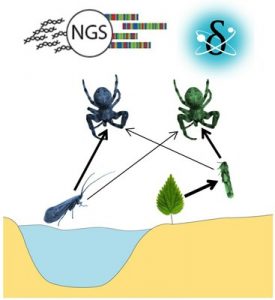
Working title: Pollution and invasive plants reduce the impact of aquatic subsidies on riparian food webs.
Supervising scientists: Martin Entling, Nanki Sidhu, Klaus Schwenk.
Doctoral researcher: Maike Huszarik
Approach: Emerging aquatic insects play an important role in linking streams with surrounding terrestrial food webs, by providing valuable nutrients to riparian predators. The food web ecology project will study indirect effects in the riparian food web in response to anthropogenic stressors of streams.
Contact: Martin Entling, Ecosystem Analysis
Emerging aquatic insects play an important role in linking streams with surrounding terrestrial food webs, by providing valuable nutrients to riparian predators. However, the presence of chemical pollution and invasive plant species in streams can alter this connection and indirectly affect the terrestrial ecosystem. Previous studies have found changes in riparian food webs near streams containing higher levels of pesticides, but the mechanism behind this has not been fully investigated.
The food web ecology project will study indirect effects in the riparian food web in response to anthropogenic stressors of streams. To achieve this, we will perform a field study on two riparian insectivores, namely bats and spiders, at 15 – 20 stream sites. The sites are similar in natural structure, but differ in exposure to pollution as they are located either before or after agricultural and urban landscapes. At each site, bat calls will be recorded to measure the abundance of different species and their feeding attempts. Spiders will also be collected to characterize the contribution of aquatic subsidies to their diets. This will be done using gut content analysis via metabarcoding, and stable isotope analysis. We will also measure pesticides and waste water markers at each study site, and sample emerging insects from the streams.
Due to direct effects of chemical pollution on emerging aquatic insects, we expect a negative response in the diets and behaviour of predators at sites with higher pollution. For example, polluted sites may have lower bat abundance with fewer hunting calls, and the contribution of aquatic subsidies to spider diets could also decrease. These effects may also differ for generalist versus specialist predators. By combining the information from this study with other Systemlink projects, we can better understand how the effects of anthropogenic stressors in streams propagate to and change the riparian ecosystem.
PhD project: Subsidy quality
Working title: Terrestrial food webs are affected by the selective impacts of aquatic micropollutants on insect emergence.
Supervising scientists: Mirco Bundschuh, Ralf B. Schäfer and Alessandro Manfrin
Doctoral researcher: Sebastian Pietz
Approach: Resource fluxes from freshwaters to adjacent terrestrial ecosystems can be of high relevance for the receiving system. However, micropollutants can adversely affect these ecosystems. It is thus hypothesized in this PhD project that micropollutant-induced adverse effects on the aquatic emergence may propagate to a reduction in predator fitness and potential top-down effects.
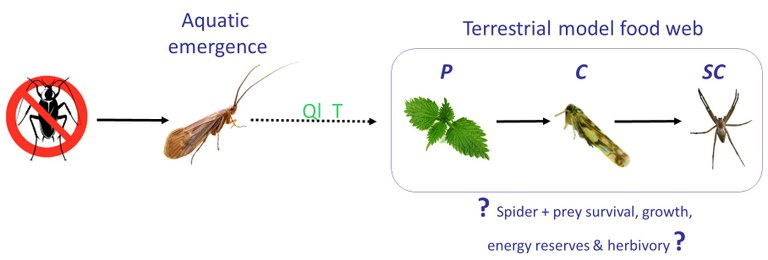
Resource fluxes (subsidies) from freshwaters to adjacent terrestrial ecosystems can be of high relevance for the receiving system, because emerging merolimnic insects can constitute a major part of the diet of riparian predators. However, micropollutants can adversely affect freshwater ecosystems, in turn, altering the connectivity across ecosystems. It is thus hypothesized in this PhD project that micropollutant-induced adverse effects on the aquatic emergence (i.e., diversity, biomass, temporal availability and quality) may propagate to a reduction in predator (i.e., spider) fitness and potential top-down effects.
In this year’s experiment, we will examine the effects of a combination of different micropollutants (i.e., organic pesticide mixture and Cu) and food levels (i.e., low and high quality) on the biomass and quality (measured as essential amino acids and PUFAs) of the merolimnic aquatic insect Chironomus riparius over several generations to assess potential alterations over time. Additionally, chironomids will be fed to a terrestrial model predator (i.e., a spider) to investigate if potential treatment-related effects (i.e., altered prey quality) may affect the physiological fitness of spiders.
Subsequently, microcosms inside the RSM will be used featuring a simplified food web consisting of a terrestrial predator (i.e., spiders), terrestrial herbivorous prey, a plant, and aquatic prey (i.e., emerging merolimnic insects). Spider survival, growth, fitness (essential amino acids and PUFAs),
and usage of prey items (via stable isotope analysis) as well as terrestrial prey abundance and herbivory will be monitored to infer treatment-related effects.
PhD project: Subsidy dynamics
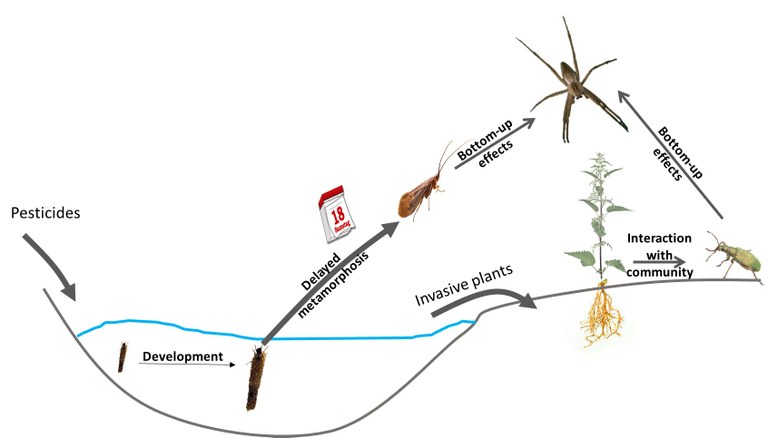
Working title: Anthropogenic changes in the water-to-land transition zones modify the quality and temporal availability of aquatic subsidy for terrestrial predators.
Supervising scientists: Mirco Bundschuh, Carsten A. Brühl, Mira Kattwinkel.
Doctoral researcher: Sara Kolbenschlag
Approach: Insects associated with contaminated water bodies can result in an altered emergence pattern. To investigate effects of pesticides on aquatic insects, a lab experiment with the non-biting midge Chironomus riparius will be conducted.
Pesticides which are regularly applied in agricultural landscapes often enter adjacent water bodies via run off and spray drift. Thus, insects associated with those contaminated water bodies are exposed in their aquatic phase (eggs and larvae) which can result in an altered emergence pattern and may also affect the quality of emerging insects in terms of prey for terrestrial predators. To investigate effects of pesticides on aquatic insects, a lab experiment with the non-biting midge Chironomus riparius will be conducted over five generations. Copper and a pesticide mixture as chemical stressors will be combined with high- and low-quality food and the emergence dynamics as well as the emergence quality will be assessed. Therefore, lipid content, fatty acid composition and amino acid content will be analysed as well as indicators for oxidative stress.
Another anthropogenic stressor for aquatic insects is the biocide Bacillus thuringiensis var. israelensis (Bti), a mosquito control agent which is regularly applied in the floodplains of the German Upper Rhine Valley. To examine the effect of Bti on the aquatic insect community, a field study in flood plain mesocosms will be conducted between spring and autumn. In addition to direct effects on diversity, richness and quality of the insect community, indirect effects on prey (protozoan) and predators (spiders) will be investigated.
PhD project: Bottom-up effects
Working title: Bottom up effects of aquatic micropollutants and invasive riparian plants on terrestrial food chain and community composition.
Supervising scientists: Jens Schirmel, Mirco Bundschuh, Kai Riess.
Doctoral researcher: Daniel Schmitz
Approach: Aquatic micropollutants and invasive plant species are factors that strongly impact riparian ecosystems. In this project, the bottom-up effects of these factors exhibited over multiple trophic levels will be investigated.
Contact: Jens Schirmel, Ecosystem Analysis
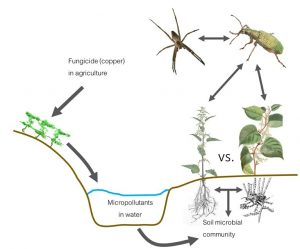
Aquatic micropollutants and invasive plant species are factors that strongly impact riparian ecosystems in many different forms. In this project, the bottom-up effects of these factors exhibited over multiple trophic levels will be investigated.
The project is split into two experiments: a field study investigating the independent contribution of both factors on riparian soil microbial and invertebrate community structure and a laboratory experiment testing the causal effects of micropollutants on the soil microbial community and subsequent effects on the focal plant species and focal herbivores determined in the field study.
In the field study, stream sections with varying pollution levels where the focal invasive plant species are present (Impatiens glandulifera or Fallopia japonica) will be investigated. At these sites, soil microbial (via DNAmetabarcoding) and invertebrate community structure as well as physiological fitness parameters of the focal plants and representative invertebrates will be determined and compared with sites, that have higher or lower pollution levels. In the laboratory experiment, microcosms filled with a representative riparian soil and its native soil microbial community will be used. The micropollutants will be simulated by introducing copper in different concentration levels into the soil prior to planting one of the focal plant species into the pot. The plants will be grown for two seasons. Root, leaf and soil samples will be taken in regular intervals. At these points, the physiological fitness of each plant will be assessed as well using image-based analysis. In the second season, herbivores will be introduced into the pots.
After the experiment, the soil fungal community will be characterised (via DNA-metabarcoding) and the morphological and physiological fitness of the focal plants and of higher trophic levels will be measured.
PhD project: Ecological stress response modelling
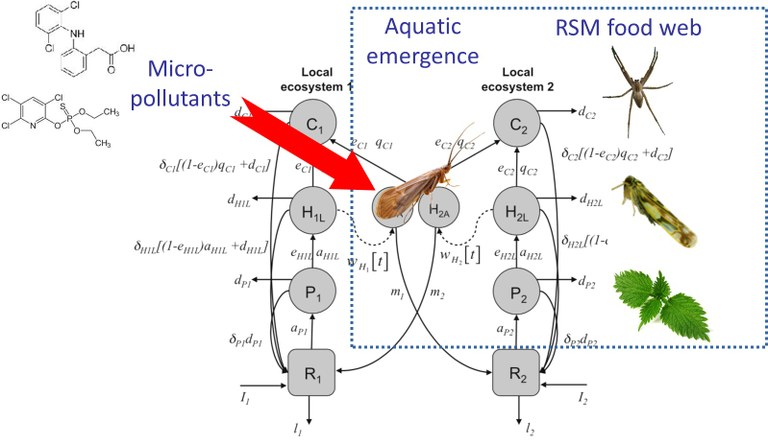
Working title: Modelling the response of a terrestrial food web to a change in aquatic subsidies through environmental stress.
Supervising scientists: Ralf B. Schäfer, Mira Kattwinkel, Jens Schirmel.
Doctoral researcher: Stephen Osakpolor
Approach: Environmental stressors can have effects on the structure and function of meta-environmental systems. In the first part of the project, a description of existing meta-ecosystem ecological models will be done.
Contact: Ralf Schäfer, Quantitative Landscape Ecology
Environmental stressors can have effects on the structure and function of meta-environmental systems. Meta-ecosystem ecological models through abstraction can help us improve understanding and make predictions of such complex systems. In the first part of the project, a description of existing meta-ecosystem ecological models will be done. Inputs from the literature review regarding identified model gaps and needed parameters to further ecological response stress modelling, will be incorporated in developing a meta-ecosystem ecological model that studies the effect of aquatic chemical pollution on the linked riparian food web.
The model will consist of a simple tri-trophic riparian food-web consisting of a plant, prey, and predator, which is subsidized by prey from the linked aquatic ecosystem. The model will incorporate a sub-model for environmental stressors of the aquatic ecosystem with endpoints on both the quantity and quality of the aquatic prey. The riparian food web will also have links with the biogeochemical cycles of limiting nutrients, and ecosystem functions such as primary production can be measured. In the first instance, it will be parameterized by literature and estimated parameter ranges to identify highly sensitive parameters. As soon as sufficient experimental data from other SystemLink projects are available, the developed model will be fully parametrized empirically.
PhD project: Meta-ecosystem modelling of aquatic-terrestrial bottom-up interactions
Working title: Meta-ecosystem modelling of aquatic-terrestrial bottom-up interactions.
Supervising scientists: Ralf B. Schäfer, Andreas Lorke, Alessandro Manfrin
Doctoral researcher: Adeel Ahmed
Approach: This project will focus on the flood-mediated effects of stressors such as aquatic micro pollutants and invasive species on terrestrial recipient communities. The work involves the development of a spatially explicit network model, which will include the above-mentioned stressors. The model should consider pollutant transport stream to land, bio geochemical cycles, soil physical properties, ecosystem functions, and riparian bottom-up plant-herbivore tropic interactions as well as a dynamic exchange between riparian patches. The model will be used to test the hypothesis that environmental stressors destabilize the dynamics of the riparian tropic system via bottom-up effects. Moreover, the project will work in close cooperation with an ecological modelling project on top-down effects.
Contact: Ralf Schäfer, Quantitative Landscape Ecology
